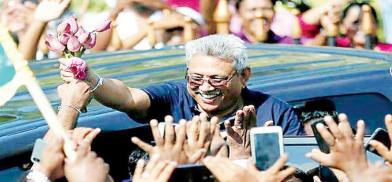Rajapaksa’s Redux: Jingoism 1, Justice 0
The return of a Rajapaksa to the island’s highest office coincides with a potent form of majoritarianism in Sri Lanka, driven simultaneously by jingoism and fear among the electorate, writes Arman Sidhu for South Asia Monitor

Following his decision to pardon and release former army officer Sunil Ratnayake, Sri Lankan President Gotabaya Rajapaksa has reopened new wounds stemming from his country’s devastating civil war. Though over a decade has passed since the conclusion of Sri Lanka’s war with the now-defunct Liberation Tigers of Tamil Eelam (LTTE), the country’s minority Tamil community continues to endure lapses in justice for civilians killed by perpetrators that include members of the Sri Lankan military and police.
For his part, Ratnayake’s case is particularly harrowing. On December 20th, 2000, Ratnayake slit the throats of eight Tamil civilians, half of whom were children, the youngest just five years old. Upon further investigation, it was revealed that none of the victims were considered combatants but, rather, internally displaced refugees who returned home, with official approval, to inspect their property and gather necessary materials.
As a result of his actions, Ratnayake went from an esteemed Staff Sergeant in the Sri Lankan Army to a death row inmate, offering a sliver of hope in the integrity and recourse provided through the Sri Lankan judicial system. The Mirusuvil Massacre, as the event would later be known, resurfaced several times in both domestic and international media outlets, largely due to the fact that the event was one of a limited number of instances in which human rights violations committed during the war resulted in some form of legal accountability.
Nevertheless, in spite of a Supreme Court ruling and 13 years’ worth of judicial procedures, Rajapaksa, in a nod to his base, ordered the Ministry of Justice to release Ratnayake. With much of the world’s media engulfed by the ongoing COVID-19 pandemic, Rajapaksa’s timing of the pardon is curious, but failed to go unnoticed by dedicated observers like Amnesty International. In prior reactions, the president has been swift and adamant in his dismissal of past (and fake) claims regarding Ratnayake’s release.
Yet, even as Rajapaksa weathers a deluge of criticism from prominent NGOs and activist groups for his decision, the reaction among his political base reveals little more than a heaping of praise. Among Sinhalese nationalists, the release of Ratnayake elicits a strong show of support, with many hailing Ratnayake as a war hero. Such a reception is not lost on the Sinhalese political elite, some of whom have openly lobbied for Ratnayake’s release. Considering the fact that it took 15 years to convict Ratnayake in the first place only amplifies the stark divisions among Sri Lanka’s society today.
To make sense of Rajapaksa’s decision only necessitates an evaluation of the Island’s current circumstances. Having campaigned on a platform of strongman politics and technocracy, Rajapaksa’s victory emphasized the need to restore the country’s security and economic prosperity. At present, few indicators bode well for the Rajapaksa government. Amid the heavy crackdown by authorities following last year’s Easter Day bombings, relations between the Sri Lankan government and the country’s Muslim community appeared frayed, at a time when fears of radicalization persist.
On the economic front, Sri Lanka’s GDP growth has slumped for four straight years, a trend that is unlikely to reverse in the wake of COVID-19’s debilitating impact on global markets. Joblessness, particularly among the youth, offers bleak prospects for young Sri Lankans. Furthermore, the island’s dependency and exposure to the tourism sector makes it especially vulnerable to a sharp recession.
With few policy tools available at his disposal, Rajapaksa’s release of Ratnayake serves to remind the electorate of Rajapaksa’s appeal. Namely, a legacy affixed to victory through a horrific ending to a war estimated to have claimed the lives of as many as 100,000 Sri Lankans. The return of a Rajapaksa to the island’s highest office coincides with a potent form of majoritarianism in Sri Lanka, driven simultaneously by jingoism and fear among the electorate. The result is a mindset of guardedness among the Sinhalese and, in turn, a deeper alienation among both the Tamil and Muslim minorities.
Though the likelihood of a revived insurgency among the Tamil community in the near term remains infinitesimal, the best-case scenario regarding the release of Ratnayake ends with strongly worded condemnations. However, at worst, the Rajapaksa government risks a redux not unlike the conditions that fomented the violent rise of the Tamil minority throughout the 1970s and 1980s. Though his attempt may be to revise history, Rajapaksa instead looks more likely to repeat it, as grievances among the Tamil and Muslim minorities continue to go unheard.
Such conditions suggest that while it may have taken Sri Lanka just over a quarter-century to end the war, actions like this one serve only to prolong the country’s recovery.
(The writer is an American educator and political analyst, currently Research Fellow at Rise to Peace, a non-profit based in Washington D.C. Views expressed are personal)










Post a Comment